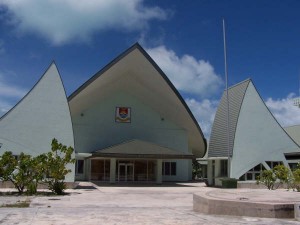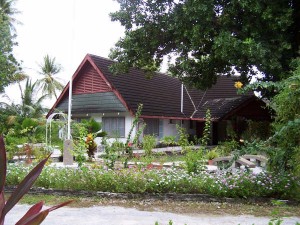Kiribati
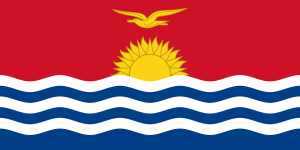
Kiribati
Kiribati ([kɪribas] kirr-i-bas or ˌkɪrəˈbɑdi; Gilbertese: [ˈkiɾibas]), officially the Republic of Kiribati, is an island nation in the central tropical Pacific Ocean. The permanent population is just over 100,000 (2011) on 800 square kilometres (310 sq mi). The nation is composed of 32 atolls and one raised coral island, Banaba, dispersed over 3.5 million square kilometres, (1,351,000 square miles) straddling the equator, and bordering the International Date Line at its easternmost point.
The name Kiribati is the local pronunciation of Gilberts, which derives from the main island chain, named the Gilbert Islands after the British explorer Thomas Gilbert, who was the first European to come into contact with them. The capital, South Tarawa, consists of a number of islets connected through a series of causeways, located in the Tarawa archipelago. Kiribati became independent from the United Kingdom in 1979. It is a member of the Commonwealth of Nations, the IMF and the World Bank, and became a full member of the United Nations in 1999.
Etymology
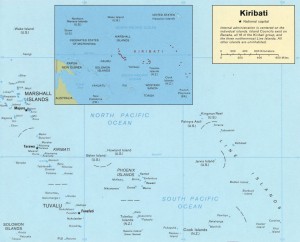 Kiribati was named in French by captains Krusenstern and Louis Isidore Duperrey “îles Gilbert,” Gilbert Islands, after the British Captain Thomas Gilbert, who sighted the islands in 1788. The current name, Kiribati, is an adaptation of “Gilberts,” from the former European name the “Gilbert Islands”. Although the indigenous Gilbertese language name for the Gilbert Islands proper is Tungaru, the new state chose the name Kiribati, the Gilbertese rendition of Gilberts, as an equivalent of the former colony to acknowledge the inclusion of islands never considered part of the Gilberts chain.
Kiribati was named in French by captains Krusenstern and Louis Isidore Duperrey “îles Gilbert,” Gilbert Islands, after the British Captain Thomas Gilbert, who sighted the islands in 1788. The current name, Kiribati, is an adaptation of “Gilberts,” from the former European name the “Gilbert Islands”. Although the indigenous Gilbertese language name for the Gilbert Islands proper is Tungaru, the new state chose the name Kiribati, the Gilbertese rendition of Gilberts, as an equivalent of the former colony to acknowledge the inclusion of islands never considered part of the Gilberts chain.
History
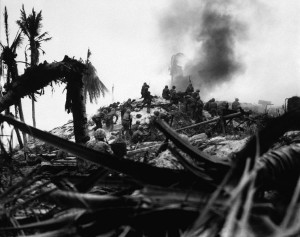 American marines assault a Japanese bunker during the Battle of Tarawa, November 1943.
American marines assault a Japanese bunker during the Battle of Tarawa, November 1943.
History of Kiribati – Early History
The area now called Kiribati has been inhabited by Micronesians speaking the same Oceanic language since sometime between 3000 BC and AD 1300. The area was not isolated; invaders from Tonga, Samoa, and Fiji later introduced Polynesian and Melanesian cultural aspects, respectively. Intermarriage tended to blur cultural differences and resulted in a significant degree of cultural homogenisation.
Colonial Era
The islands were first sighted by British and American ships in the late 18th and early 19th centuries. The main island chain was named the Gilbert Islands in 1820 by a Russian admiral, Adam von Krusenstern, and French captain Louis Duperrey, after a British captain named Thomas Gilbert, who crossed the archipelago in 1788 when sailing from Australia to China.
From the early 19th century, Western whalers, merchant vessels and slave traders visited the islands, introducing diseases and firearms. The first British settlers arrived in 1837. In 1892 the Gilbert Islands consented to become a British protectorate together with the nearby Ellice Islands. They were administered by the Western Pacific High Commission based in Fiji. Together they became the crown colony of the Gilbert and Ellice Islands in 1916. Christmas Island (or Kiritimati) became part of the colony in 1919 and the Phoenix Islands were added in 1937. Sir Arthur Grimble was a cadet administrative officer based at Tarawa (1913–1919) and became Resident Commissioner of the Gilbert and Ellice Islands colony in 1926.
Tarawa Atoll and others of the Gilbert group were occupied by Japan during World War II. Tarawa was the site of one of the bloodiest battles in US Marine Corps history. Marines landed in November 1943; the Battle of Tarawa was fought at Kiribati’s former capital Betio on Tarawa Atoll.
Some of the islands of Kiribati, especially in the remote Line Islands, were formerly used by the United States and United Kingdom for nuclear weapons testing including hydrogen bombs in the late 1950’s and early 1960’s.
Independence to Present Day
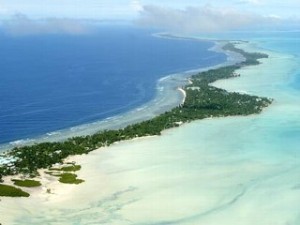 The Gilbert and Ellice Islands gained self-rule in 1971, and were separated in 1975 and granted internal self-government by Britain. In 1978 the Ellice Islands became the independent nation of Tuvalu. The Gilbert Islands became independent as Kiribati on 12 July 1979. Although the indigenous Gilbertese language name for the Gilbert Islands proper is “Tungaru”, the new state chose the name “Kiribati”, the Gilbertese rendition of “Gilberts”, as an equivalent of the former colony to acknowledge the inclusion of Banaba, the Line Islands, and the Phoenix Islands, which were never considered part of the Gilberts chain. In the Treaty of Tarawa, signed shortly after independence and ratified in 1983, the United States relinquished all claims to the sparsely inhabited Phoenix Islands and those of the Line Islands that are part of Kiribati territory.
The Gilbert and Ellice Islands gained self-rule in 1971, and were separated in 1975 and granted internal self-government by Britain. In 1978 the Ellice Islands became the independent nation of Tuvalu. The Gilbert Islands became independent as Kiribati on 12 July 1979. Although the indigenous Gilbertese language name for the Gilbert Islands proper is “Tungaru”, the new state chose the name “Kiribati”, the Gilbertese rendition of “Gilberts”, as an equivalent of the former colony to acknowledge the inclusion of Banaba, the Line Islands, and the Phoenix Islands, which were never considered part of the Gilberts chain. In the Treaty of Tarawa, signed shortly after independence and ratified in 1983, the United States relinquished all claims to the sparsely inhabited Phoenix Islands and those of the Line Islands that are part of Kiribati territory.
Overcrowding has been a problem. In 1988 it was announced that 4,700 residents of the main island group would be resettled onto less-populated islands. Teburoro Tito was elected president in 1994. Kiribati’s 1995 act of moving the international date line far to the east to encompass the Line Islands group, so that it would no longer be divided by the date line, courted controversy. The move, which fulfilled one of President Tito’s campaign promises, was intended to allow businesses all across the expansive nation to keep the same business week. This also enabled Kiribati to become the first country to see the dawn of the third millennium, an event of significance for tourism. Tito was re-elected in 1998. Kiribati gained UN membership in 1999.
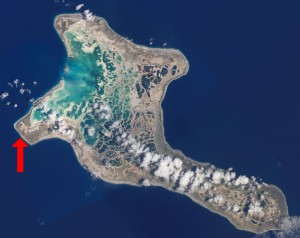 In 2002 Kiribati passed a controversial law enabling the government to shut down newspapers. The legislation followed the launching of Kiribati’s first successful non-government-run newspaper. President Tito was re-elected in 2003, but was removed from office in March 2003 by a no-confidence vote and replaced by a Council of State. Anote Tong of the opposition party Boutokaan Te Koaua was elected to succeed Tito in July 2003. He was re-elected in 2007.
In 2002 Kiribati passed a controversial law enabling the government to shut down newspapers. The legislation followed the launching of Kiribati’s first successful non-government-run newspaper. President Tito was re-elected in 2003, but was removed from office in March 2003 by a no-confidence vote and replaced by a Council of State. Anote Tong of the opposition party Boutokaan Te Koaua was elected to succeed Tito in July 2003. He was re-elected in 2007.
In June 2008, Kiribati officials asked Australia and New Zealand to accept Kiribati citizens as permanent refugees. Kiribati is expected to be the first country to lose all its land territory to global climate change. In June 2008, the Kiribati president Anote Tong said that the country has reached “…the point of no return.” He added, “To plan for the day when you no longer have a country is indeed painful but I think we have to do that.”
In early 2012, the government of Kiribati purchased the 2,200-hectare Natoavatu Estate on the second largest island of Fiji, Vanua Levu. At the time it was widely, but incorrectly, reported that the Government planned to evacuate the entire population of Kiribati to Fiji. However, in April 2013, President Tong began urging citizens to evacuate the islands and migrate elsewhere.
The Kiribati Constitution, promulgated 12 July 1979, provides for free and open elections. The executive branch consists of a president (te Beretitenti), a vice-president and a cabinet (the president is also chief of the cabinet and must be an MP). The constitution requires that the president be nominated from among elected legislators, and limits the office to three four-year terms. The cabinet is composed of the president, vice-president, and 10 ministers (appointed by the president) who are members of the House of Assembly.
The legislative branch is the unicameral Maneaba Ni Maungatabu (House of Assembly). It has elected members, including by constitutional mandate a representative of the Banaban people in Fiji (Banaba Island, former Ocean Island), in addition to the attorney general, who serves as an ex-officio member. Legislators serve for a four-year term.
The constitutional provisions governing administration of justice are similar to those in other former British possessions in that the judiciary is free from governmental interference. The judicial branch is made up of the High Court (in Betio) and the Court of Appeal. The president appoints the presiding judges.
Local government is through island councils with elected members. Local affairs are handled in a manner similar to town meetings in colonial America. Island councils make their own estimates of revenue and expenditure and generally are free from central government controls. There are a total of 21 inhabited islands in Kiribati. Each inhabited island has its own council. Since independence, Kiribati is no longer divided into districts, see Subdivisions of Kiribati
Kiribati has formal political parties but their organisation is quite informal. Ad hoc opposition groups tend to coalesce around specific issues. Today the only recognisable parties are the Boutokaan te Koaua Party,Maneaban te Mauri Party, Maurin Kiribati Party and Tabomoa Party. There is universal suffrage at age 18.
In government terms, Kiribati has a police force, which carries out law enforcement and paramilitary duties—and has small police posts on all islands but no military. The police have one patrol boat.
Island Groups
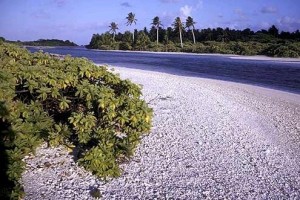 Line Islands: Caroline Atoll channel between west side of Long Island and Nake Island.
Line Islands: Caroline Atoll channel between west side of Long Island and Nake Island.
There are a total of 21 inhabited islands in Kiribati. Kiribati was formally divided into districts until independence. The country is now divided into three island groups, including a group that unites the Line Islands and the Phoenix Islands (ministry at London,Christmas). The groups have no administrative function. Each inhabited island has its own council: three councils on Tarawa: Betio, South-Tarawa, North-Tarawa—and two councils on Tabiteuea). The original districts were:
- Banaba
- Tarawa Atoll
- Northern Gilbert Islands
- Central Gilbert Island
- Southern Gilbert Islands
- Line Islands.
The island groups include:
- Gilbert Islands
- Phoenix Islands, the second largest protected marine reserve in the world since the establishment of the Chagos Archipelago as a marine reserve.
- Line Islands.
Four of the former districts (including Tarawa) lie in the Gilbert Islands, where most of the country’s population lives. Five of the Line Islands are uninhabited (Malden Island, Starbuck Island, Caroline Island, Vostok Island and Flint Island). The Phoenix Islands are uninhabited except for Kanton, and have no representation. Banaba itself is sparsely inhabited now. There is also a non-elected representative of the Banabans on Rabi Island in Fiji. Each of the 21 inhabited islands has a local council that takes care of the daily affairs. Tarawa Atoll has three councils: Betio Town Council, Te Inainano Urban Council (for the rest of South Tarawa) and Eutan Tarawa Council (for North Tarawa).


